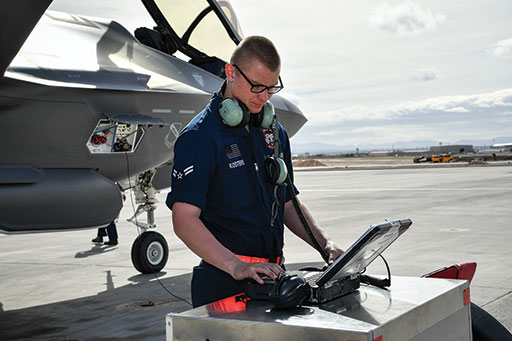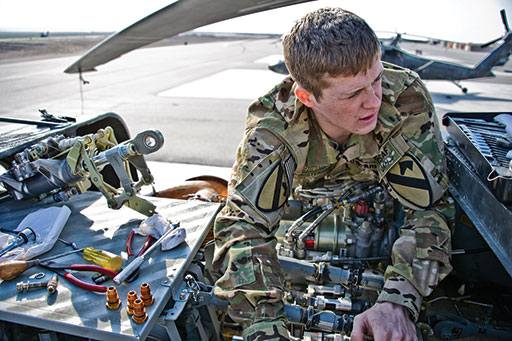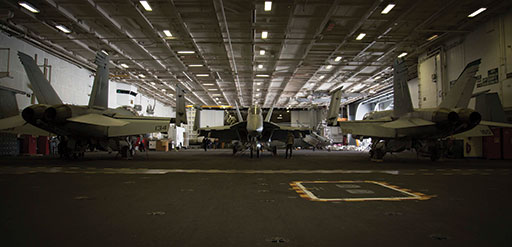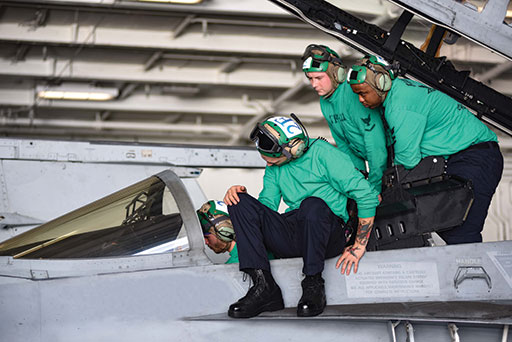Is the much-anticipated shortage of commercial aircraft mechanics going to impact the ability of the U.S. military to keep its combined fleets prepared
If you’re involved in any way with aircraft operations and/or maintenance, you can’t help but have heard that we’re standing on the precipice of what many believe will be an industry-changing shortage of pilots and aircraft maintainers.
Highlighting the need for maintainers in particular, according to a recent report by global business analysts Oliver Wyman, the gap between the available pool of experienced aircraft maintainers and the need will grow to nine-percent in the next 10-years.
The report attributes much of that shortage to the fact that over that period a large number of the current Baby Boomer-fueled workforce will retire. Obviously, that’s putting a huge burden on the commercial side to find, train and retain the numbers of mechanics they will need to keep the global fleet flying.
But, you ask, should this prediction come to be true, what impact will it have on the U.S. military’s ability to keep its aging and diverse fleet of aircraft, rotorcraft and unmanned aerial systems mission ready?
To find the answer, Aviation Maintenance contacted representatives (in alphabetical order) of the U.S. Air Force, U.S. Army and U.S. Navy to get current insights on the maintenance population in the U.S. military.

U.S. Air Force
It’s not surprising that the U.S. Air Force ended FY2017 with over 5,300 aircraft of all shapes and sizes in its global inventory. And, while the need to keep each and every one of them mission ready is a priority, that doesn’t mean that the Air Force’s aircraft maintenance ranks have been immune to budget cuts.
In fact, as recently as the end of FY15, past budget restrictions had led the Air Force to experience a deficit of some 4,000 aircraft maintainers. But that was then…
As Chief Master Sargent Dong Kim, Aircraft Systems Career Field Manager, U.S. Air Force explained it; over the past two years they have made significant inroads into filling that gap to a point where today, the deficit is down to only 400 maintainers.
“The original shortage was the result of a decade’s worth of program changes within the Air Force as a whole. Sequestration and other budgetary restraints actually combined to cause the drop,” he said. “It was the purposeful cuts that took place and not a lack of interest.”
“A key point is the fact that aircraft maintainers in the Air Force typically retain better on an aggregate perspective than the rest of the Air Force in comparison,” Chief Kim said. “From my perspective of having served over 27-years as an Air Force aircraft maintainer, is that there is a lot of personal and national pride in what we do.”
“We do things very well and we work with the same aircraft and crews on a daily basis,” he said. “So there is a great pride of ownership whether we are maintaining a 60-year old aircraft or a brand new F-35.”
“It’s very unique, very precise, very different work than what you see on the civilian side,” Chief Kim said. “There are some similarities when you look at the large, wide-body aircraft the Air Force owns, but all the other aircraft and systems are very specific to our nature. The challenge is absolutely very attractive.”
But, while Air Force maintainers do what they do for pride and service to our country, Chief Kim, as does the entire Air Force, stresses the need to continually offer attractive retention programs to ensure it retains its skilled professionals.
“For example, we offer higher tenure extensions for technicians in specialized areas where we know there is a critical need for their specific skill set in the civilian world,” he said. “If they go beyond their higher tenure we have the ability to promote to retain those Airmen. The Air Force offers lots of opportunities for advancement.”
“In some instances, our recruiters have brought in prior-duty service maintainers who have been separated from the military for as many as 10-years,” Chief Kim explained. “They came back at the same grade as when they left. The program was very successful. And not just with prior Airmen. We also recruited prior Army, Navy and Marine Corps maintainers. They all came back to direct duty. No backtracking.”
While current recruitment efforts have been successful, Chief Kim said that the Air Force has made it a priority to ensure the pipeline of qualified Airmen maintainers is sufficient to meet ongoing needs.
“It’s not that we met the mark, we must continue to meet it as we grow the aircraft inventory and maintenance needs,” he said. “For example, we need to support the F-35 growth and we need more maintainers specifically trained to do that. This aircraft has more integrated systems so our technicians need to be trained to have a more integrated approach that is more diverse and holistic.”
“Technology is helping us do that,” Chief Kim said. “Aircraft systems are more advanced and integrated with more maintenance capabilities built-in now. We need to develop and train our technicians to meet that changing need. It’s a very exciting time. Our maintainers are excited to be here.”

U.S. Army Aviation
According to Command Sergeant Major Gregory M. Chambers, Aviation Branch Command Sergeant Major, U.S. Army Aviation Center of Excellence, Fort Rucker, Alabama, the Army is not currently experiencing, nor does it anticipate, that it will have any problems meeting its requirements for trained aircraft – and particularly in its case – helicopter maintenance personnel.
“The Army as a whole is not having any problems with enlisting maintainers. But the important point is first and foremost, whether they are maintaining an aircraft or flying it, the number one thing they have to preform is service to our country,” he said. “They are an Army soldier above all.”
“We have approximately 11 different Military Operational Specialties (MOSs) that we train for to work on our three major aircraft type, which are the CH-47 (Chinook), UH-60 Lima/Mike (Blackhawk), and the AH-64 Delta and Echo (Apache),” CSM Chambers said. “We also have training for our UAS Grey Eagle and Shadow platforms.”
While the Army offers a diverse array of occupations for aircraft maintainers, CSM Chambers stressed the fact that each specialty and training program is unique to its assigned job.
“The big difference between the Army and a mechanic in civil aviation is that the civilian mechanic with an A&P license is asked to do a myriad of tasks on the aircraft. They kind of go along from an apprentice to a journeyman to a master-type career path,” he said. “It can take 30-years to gain their level of high proficiency.”
“Since we don’t have that long in the Army, we have a variety of different Military Occupational Skills that a soldier can concentrate on and become very proficient in that skill very quickly,” CSM Chambers said. “For example, our 15 Bravo, which are aircraft powerplant repair mechanics, only work on engines: main engines and APUs. Our 15 Delta power train mechanics only work on power trains. Nothing else. Our mechanics are very specialized and take great pride in their areas of expertise.”

CSM Chambers also said that while the Army is currently having no problem filling its requirements for enlisted personnel to meet ongoing maintenance needs, they are faced with the ongoing challenge of retaining these valuable people.
“Where we run into problems is retaining maintenance experience at our Staff Sargent grade,” he said. “That individual has between six- and 12-years experience. It’s not all areas, but a few in particular right now include AH-64 mechanics, UAS mechanics, UAS operators and air traffic controllers.”
To help keep these highly skilled professionals in the service, CSM Chambers said that the Army has developed a number of incentives retention bonuses and 24-different credentialing/licensing programs to earn enlisted military personnel.
“One of the key credentialing programs we offer is the FAA Airframe and Powerplant license,” he said. “The FAA says they need a minimum of 30-months of experience in various MOSs before they can take the test so they stay to get the experience they need. The A&P license is what every technician wants because when they do get out of the Army are prepared for a civilian job.”
“At the end of the day the Army can offer a soldier a large cash bonus or training incentive to enlist for another six-years, but sometimes it’s not the money at all,” CSM Chambers said. “It can be any number of reasons they want to leave the service: quality of life, career change, family status change or other situations.”

U.S. Naval Aviation
With no disrespect meant to the other U.S. armed forces, the maintainers charged with keeping the U.S. Navy’s diverse fleet of fixed- and rotary-wing aircraft have, arguably, the hardest task. After all, they’re the ones challenged with keeping the Navy’s front-line aircraft in top shape, while located hundreds of miles out at sea.
But, that high-level of adversity is exactly what draws so many want-to-be Navy aircraft maintainers into that branch of service in the first place.
“Working on Navy aircraft as part of a squadron is a unique experience and one that sets the Navy apart from all of our competition,” stated Lieutenant Commander Jessica McNulty, spokesman for Navy Recruiting Command. “Nowhere else is a person going to get the education and experience we offer as well as the perks of continued college or technical training, as well as a chance to see the world – all paid for by the Navy.”
“And it’s all while you work aboard one of our state-of-the-art aircraft carriers or shore maintenance facilities,” she added. “The friendships and camaraderie will last a lifetime. No other employer offers the opportunity of being forged by the sea the way the Navy does.”
But, even with all that Navy life offers it, like the other armed forces it does face challenges when it comes to having adequate numbers of trained aircraft maintenance technicians.
According to Captain David Whitehead, Head Officer/Community Manager, U.S. Navy, while there are currently adequate numbers of aircraft technicians in the aggregate levels for Naval Aviation, there are areas where they are experiencing, “areas of sub-optimal levels of technicians within specific specialty skills.”
Capt. Whitehead explained that currently they are below the ideal counts for technicians specializing in key areas including, engine maintenance, aircraft electricians in San Diego, structural mechanics, safety equipment/life support and electronics technicians.
“The Navy’s high tempo operations and deployment frequency, specifically for TACAIR (Tactical Air Command) squadrons, challenge the retention of our aircraft technicians,” he said. “As we continue to grow and modernize the Navy, we face continued competition for talent, especially within the civil sector of the aviation industry.”
“As we face this increased competition for our talented workforce, both our monetary and non-monetary incentives are consistently being reviewed to ensure we attract and retain adequate levels of aircraft technicians,” Capt. Whitehead said. “Additionally, we have a process to validate future requirements and plan new accessions each year.”
“In areas where previous budgetary limitations have restricted our accessions, we are able to provide additional resources in the form of extra new recruits to bolster personnel levels,” he stated. “We also have an apprenticeship program that provides flexible manning options.”
Capt. Whitehead also explained that the Navy’s ongoing job prioritization process allows the U.S. Fleet Forces Command to adjust priorities to fill the most critical requirements on a monthly basis, which helps minimize any adverse impact to individual ratings or commands.
With regards to retaining their trained maintenance specialists, along with the monetary incentives Capt. Whitehead mentioned earlier, the Navy is also initiating ways to help current Sailors advance.
“If a Sailor has trouble advancing through the Navy’s advanced exam process, we are allowing them to extend their careers for an additional one- or two-years to enable them to take advantage of increased opportunities to complete the exam process,” he said. “Additionally, there are many initiatives that focus on offering more career choices and expanding professional development opportunities to encourage Sailors to stay Navy.
